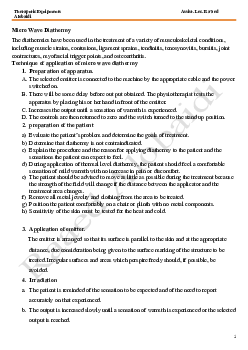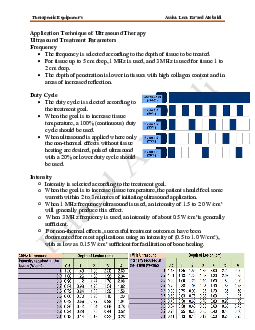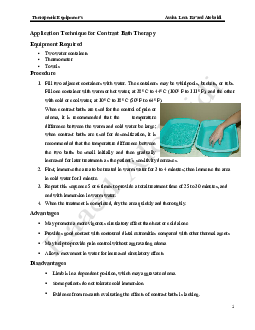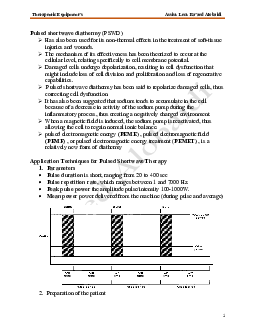

Preview text:
lOMoARcPSD|36041561
Therapeutic Equipment’s Assist Lect. Ra’aed Alobaidi
Application Technique for Ultraviolet Radiation
1. Determining Minimal Erythemal Dose of Ultraviolet for an individual
Place UV goggles on the patient and the clinician.
Remove all clothing and jewelry from and wash an area of the body least exposed to
natural sunlight. the volar forearm, abdomen, and buttocks areas usually used .
Take a piece of cardboard approximately 4 * 20 cm, and cut four square holes 2 * 2 cm in it.
Place the cardboard on the test area, and drape the area around the cardboard so that the
surrounding skin will not be exposed to UV radiation.
Place the lamp 60 to 80 cm away from, and perpendicular to, the area to be exposed.
Cover all but one of the holes in the cardboard.
Turn on the lamp. allow the lamp to warm up before turning it toward the patient. A
fluorescent lamp will reach full power and can be used within 1 minute of being turned on.
Once the lamp has reached full power, direct the beam directly toward the area to be exposed, and start the timer..
After 30 seconds, uncover the second hole.
After another 30 seconds, uncover the third hole.
After another 30 seconds, uncover the fourth hole.
After another 30 seconds, turn off the lamp.
According to this protocol, the first window will have been exposed for 120 seconds, the
second for 90 seconds, the third for 60 seconds, and the fourth for 30 seconds
The patient should observe the area for up to 4 days after exposure.
The area that shows mild reddening of the skin within 8 hours that disappears within 24 hours is treated as the MED.
2. DOSE-RESPONSE ASSESSMENT Raaed Alobaidi
The UV dose is graded according to the
individual’s erythemal response and is categorized as follows:
• Suberythemal dose (SED): No change in skin redness occurs in the 24 hours after UV exposure.
• Minimal erythemal dose (MED) or First-degree erythema (E1):The smallest dose producing
erythema within 8 hours after exposure that disappears within 24 hours after exposure
• First-degree erythema (E1): Definite redness with some mild desquamation appears within 6
hours after exposure and lasts for 1 to 3 days. This dose is generally about 2.5 times the MED. 1
Downloaded by Nga T??ng (ngahuong55@gmail.com) lOMoARcPSD|36041561
Therapeutic Equipment’s Assist Lect. Ra’aed Alobaidi
• Second -degree erythema (E2): Definite redness with some mild desquamation appears within 6 hours
after exposure and lasts for 1 to 3 days. This dose is generally about 2.5 times the MED.
• Third-degree erythema (E3): Intense erythema with edema, peeling, and pigmentation
appears within 2 hours after treatment and is like a severe sunburn. This dose is generally about 5 times the MED.
• Fourth-degree erythema (E4): Erythema with severe blistering, peeling, and exudation. This
dose is generally about 10 times the MED. Dose Latent period Appearance
Disappearance Pigmentation Desquamation
An explanation is given to the patient about what is going to happen. The patient is placed
in comfortable position and fully supported by using pillows.
3. Area of the treatment must be washed to remove cream and allow maximum
penetration of ultraviolet. 4. SED 24 No change 24 Nil Nil
When treating the face of the patient applies a thin film of petroleum jelly to his eyelids,
lips and ear lobes, as these areas are covered by very thin skin and react strongly to MED 6-12 ultraviolet. Pink <24 Nil Nil
5. E1Timing devices must be accurate and capable of measuring time in increments
appropriate for the source (e.g. second hand on a watch may be used if the MED E2 4-6 measured in second). Red 48 Slight Powdery
6. The distance from the source to the patient must be measured not estimated, most often E3 2-4 60 to 80 cm. Fiery-red& 72-96 Marked In thin sheet
7. At the end of the treatment remove the screening and petroleum jelly from the patient painful
and warn him from the expected reaction.
8. We must not forget the contraindication. E4 < 2 Angry-red& Weeks or Marked Blister more Dosage painful
Minimal Erythema Dosage at time calculation (MED) =E1 E2=E1 time * 2.5 E3=E1 time * 5 Raaed Alobaidi E4=E1 time * 10 Frequency of treatment E1 = daily E2 =every 2 days E3= every 3 days E4= every week 2
Downloaded by Nga T??ng (ngahuong55@gmail.com)




